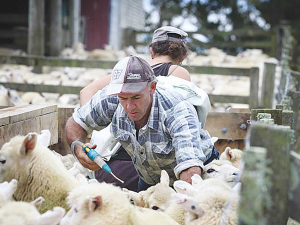Drench resistance already impacting NZ farm profits
Drench resistance is already hitting farm profits; it's not just a future problem.
 The reduction in drench effectiveness can have a devastating impact on the wellbeing and performance of livestock.
The reduction in drench effectiveness can have a devastating impact on the wellbeing and performance of livestock.
A key factor in the dramatic failure of commonly used triple drenches is that these are not effective on 27% of New Zealand sheep farms.
This latest data comes from Techion’s DrenchSmart service, a faecal egg count reduction test (FECRT) that independently reports to farmers on which drench actives are working effectively on their farms and which are not.
This level of drench failure mirrors other industry reports and again highlights the increasing productivity and sustainability threat to the sheep farming sector.
In 2020 Techion, the company that developed the FECPAKG2 parasite testing platform, reported the cost of undetected drench resistance was $48 million a year. Company founder and chief executive Greg Mirams says that building on data collected over the past 18 years, in just the past three years the company has seen triple drench failure increase from 15% of properties to 27% in 2023.
According to Wormwise programme manager, Ginny Dodunski, farms using untested, partially effective drenches will not see visual signs until things are quite serious.
“In the intervening years farms can quickly be breeding high numbers of drench resistant worms,” she explains. “If a drench is only 70% effective, each time that drench is given it’s effectively leaving 30% of the worms behind. These then have three weeks to continue to breed and lay eggs. If you’re drenching every 28 days, it’s obvious how quickly resistance can build up.”
Mirams says the days of farmers simply assuming a triple drench will work are gone.
“With limited effective quarantine protection in place, farmers are often unwittingly importing triple drench resistance onto their properties,” he explains. “Many farmers have not tested whether their drenches are effective and as a result are suffering production losses they are not aware of.”
Mirams adds that farmers generally only become aware there is a problem when they experience poor lamb performance in late autumn, or a large tail end in hoggets or ewes through the winter.
“Unfortunately, when farmers observe these production losses, the drench has likely been failing for years,” he adds. “With animal performance on many farms so dependent on the use of effective drenches, when they fail, production losses can be significant.”
The analysis also found that other drench options fared no better, with BZ/Lev combinations failing on 50% of properties, while Lev/Aba combinations were failing on 32% of properties.
“In two cases this year the change in drench efficacy on the property was so significant that we had to go back and test again as we didn’t believe the changes could be so dramatic over three years,” Mirams says.
“We’re seeing the reduction in drench effectiveness increasing significantly. This can have a devastating impact on the farmer, their mental health, their property value and the wellbeing and performance of their stock.”
He says while cases of drench failure production loss are becoming more common, there are sustainable and cost-effective options for farmers to improve productivity and reduce costs.
“It begins with a whole farm approach; instead of relying solely on drenches to control parasites farmers must utilise a range of tools. These include better nutrition of breeding stock, grazing management, pasture types, stock class options, cross-grazing and genetics.”
Mirams believe the key to the success of a farm system approach to worms is easy access to FEC data, which allows timely decisions and enables monitoring of the results of management changes.
Economic and Environmental Benefits
Techion's 2017 study, undertaken with UK retailer Sainsbury’s, reported undetected drench resistance reduced carcass value by 14%.
Analysis of the 2023 MPI statistics shows that 17,964,138 lambs went for processing in the 2022-2023 financial year.
It is calculated that undetected drench resistance could be costing the New Zealand sheep sector $98 million in 2023. At an individual farm level, for a property producing 4000 lambs annually, undetected drench resistance may reduce income by an estimated $81,200 per year.
“Improving productivity and sustainability is critical for the long-term future of the lamb supply chain,” says Gavin Hodgson, Sainsbury’s head of livestock, who was integral in commissioning the study.
“The increasing threat of drench resistance, the viability of the lamb sector and harsh climatic conditions for farms across the United Kingdom and New Zealand pose a significant threat to farmers,” he adds.
“That’s why it’s critical for farmers to know the effectiveness of the treatments they use. As well as controlling parasites this knowledge will help meet customer demand for transparency by reducing farming inputs.”
Miriams says it is critical farmers test the efficacy of the drenches they use and utilise alternative measures to control parasites and protect the drenches which are still working effectively.
OPINION: Trade Minister Todd McClay and the trade negotiator in government have presented Kiwis with an amazing gift for 2026 - a long awaited and critical free trade deal with India.
Former Agriculture Minister Nathan Guy says he's excited about his new role as NZ's Special Agricultural Trade Envoy.
A pillar of New Zealand's horticultural industry, Dr Stuart Davis, was farewelled at a well-attended funeral service in Tuakau, South Auckland, on December 18.
A stable but uncertain year lies ahead for New Zealand primary products, says Ministry for Primary Industries (MPI) Director General, Ray Smith.
Additional tariffs introduced by the Chinese Government last month on beef imports should favour New Zealand farmers and exporters.
Dairy prices have jumped in the overnight Global Dairy Trade (GDT) auction, breaking a five-month negative streak.

OPINION: If the hand-wringing, cravat and bow-tie wearing commentariat of a left-leaning persuasion had any influence on global markets, we'd…
OPINION: With Winston Peters playing politics with the PM's Indian FTA, all eyes will be on Labour who have the…